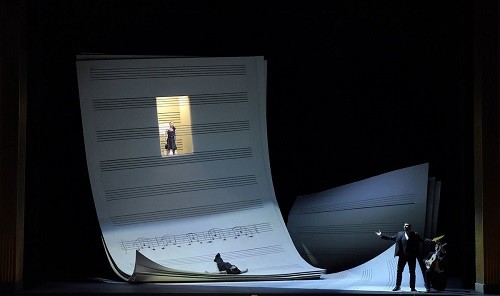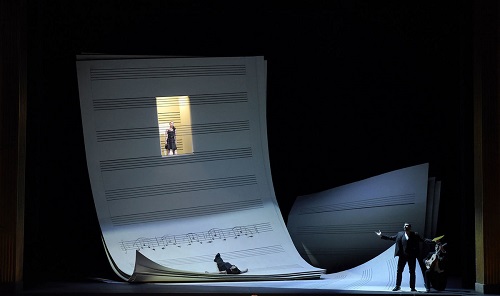 United Kingdom Edinburgh International Festival 2018 [3] – Rossini, Théâtre des Champs-Élysées’s The Barber of Seville: Soloists, Unikanti, Le Cercle de l’Harmonie / Jérémie Rhorer (conductor). Edinburgh Festival Theatre, 5.8.2018. (SRT)
United Kingdom Edinburgh International Festival 2018 [3] – Rossini, Théâtre des Champs-Élysées’s The Barber of Seville: Soloists, Unikanti, Le Cercle de l’Harmonie / Jérémie Rhorer (conductor). Edinburgh Festival Theatre, 5.8.2018. (SRT)

Cast:
Figaro – Guillaume Andrieux
Count Almaviva – Michele Angelini
Rosina – Catherina Trottmann
Bartolo – Peter Kálmán
Basilio – Robert Gleadow
Berta -Julie Pasturaud
Production:
Laurent Pelly (director, set & costume designer)
Joël Adam (lighting designer)
Works by Rossini make up two of the three staged operas in this year’s Edinburgh International Festival (the third is Gay’s Beggar’s Opera). Some might argue that’s overkill, but the Festival explains its programming by pointing out that each production has a very particular focus.
In the case of this Barber, it’s to pour the emphasis unapologetically into the music. Director Laurent Pelly goes out of his way to show that his focus is the notes on the page, right from the beginning where the productions’ curtain is a sheet of music manuscript paper, the lines of which later double as the bars of Rosina’s prison. Huge sheaves of music paper later act as the production’s sets, and the Act II storm is a huge flurry of black dots, like notes falling off their staves. Furthermore, all the notes that are written by the characters are written on music paper, something that made me realise for the first time just how many letters get written in this opera!
It’s a legitimate approach and a fair idea. The problem, however, is that it doesn’t do much for the drama, much of which develops without much ado. Sure, Pelly gives the story the space to unfold without too much fussy intrusion, but he doesn’t give his characters that much to do, and his direction of the crowds is a little too knowing. It’s a cute idea to have the musicians of the opening scene dressed in dinner suits and playing invisible string instruments to accompany the Count’s serenade, but the Carabinieri wielding music stands struck me as a bit daft, and having Figaro descend from the flies on a seat (twice) seemed to rob him of the ebullience his music cries out for. Like a lot of Pelly’s productions, it’s a good idea that’s pushed to the point of fussiness, and the whole thing feels as though it’s directed with one eyebrow knowingly raised. Half way through the first act I felt like shouting ‘We get this! Can we move on?’
It’s a good job, therefore, that the musical side of things was so strong. The production was conceived for Jérémie Rhorer’s period band Le Cercle de l’Harmonie, which perhaps explains the musical emphasis, and they’re worth it for the early 19th century attention that they bring to the sound. It’s pungent, focused, and often very surprising, but never less than beautiful and often very sweet, such as the delightful clarinet in ‘Ecco ridente in ciielo’. The percussion is zingy and often very exciting, and the strings were brilliantly clear, buzzing their way through Basilio’s slander aria like angry gnats. Rhorer’s direction was brilliantly paced throughout, with a fondness for fast tempi that fitted the drama’s rapid pace very well.
The singers were very good, too, led by a really first rate Count from young American tenor Michele Angelini. He has a light voice that suits the orchestral palette well, but it’s brilliantly agile, allowing him to negotiate the coloratura with real flair, as well as managing his regular leaps into the stratosphere with dashing aplomb. True, some of the notes were a little approximate in his aria at the end of Act II, but at least he opted to sing it. Catherina Trottmann’s Rosina was a little pale in comparison but the voice was bright and she acted convincingly. So did Peter Kálmán’s larger-than-life Bartolo, with a rasping edge to his voice that made me forgive his slight fluffing of his patter aria. Robert Gleadow’s Basilio boomed with comic presence, and Julie Pasturaud made the most of Berta’s aria. The only doubts were with the title character. Guillaume Andrieux’s light voice often sounded more like a tenor than a baritone, which meant that he got eaten alive by the basses on stage and wasn’t sufficiently contrasted with the Count, something that was only slightly compensated for by his assertive stage presence.
Still, despite Pelly’s fussy staging, a lot about this show works. It deserves to be a hit.
Simon Thompson
The Barber of Seville runs until Wednesday 8th August. The 2018 Edinburgh International Festival runs in venues across the city until Monday 27th August. For full details click here.
